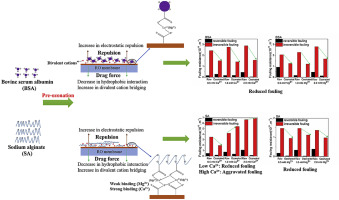当前位置:
X-MOL 学术
›
Water Res.
›
论文详情
Our official English website, www.x-mol.net, welcomes your
feedback! (Note: you will need to create a separate account there.)
Pre-ozonation for the mitigation of reverse osmosis (RO) membrane fouling by biopolymer: The roles of Ca2+ and Mg2.
Water Research ( IF 11.4 ) Pub Date : 2019-12-23 , DOI: 10.1016/j.watres.2019.115437 Zhonglong Yin 1 , Tiancheng Wen 1 , Yan Li 1 , Aimin Li 1 , Chao Long 1
Water Research ( IF 11.4 ) Pub Date : 2019-12-23 , DOI: 10.1016/j.watres.2019.115437 Zhonglong Yin 1 , Tiancheng Wen 1 , Yan Li 1 , Aimin Li 1 , Chao Long 1
Affiliation

|
Despite plenty of literatures focused on the application of pre-ozonation prior to membrane, it was still unclear about the role of divalent cations (Ca2+ and Mg2+) in reverse osmosis (RO) membrane fouling mitigation. In this study, ozone pre-treatment (0.10, 0.25 and 0.50 mg O3/mg DOC (dissolved organic carbon)) was employed to oxidize model biopolymer, which was represented by bovine serum albumin (BSA) and sodium alginate (SA) in the presence of Ca2+ and Mg2+ (0.5, 1.0 and 2.0 mM). Cross-flow filtration was conducted to investigate RO membrane fouling by concentration mode. The results showed that at appropriate ozone dose there were measurable changes in physicochemical properties of BSA and SA, including increases in particle size, hydrophilicity, density of negative charge and carboxylic groups. Pre-ozonation markedly alleviated RO fouling by BSA at ozone dose of 0.25 mg O3/mg DOC when Ca2+ and Mg2+ concentrations raised from 0.5 to 2.0 mM since the increase in electrostatic (EL) repulsion and decrease in hydrophobic (HP) interaction compensated the increase in divalent cation bridging. Similar results were obtained for SA fouling in the presence of Mg2+. In contrast, the effect of pre-ozonation on SA fouling strongly depended on the concentration of Ca2+. In brief, it mitigated SA fouling at 0.5 mM Ca2+, whereas accelerated irreversible fouling at higher Ca2+ concentration (1.0 and 2.0 mM) due to the overwhelming effect of divalent cation bridging compared to EL and HP interactions, as revealed by adsorption experiments (in-situ streaming potential measurement). Pre-ozonation shifted the fouling layer from compact to porous and weakened the adhesion forces between foulants and membrane (foulants) except for SA containing 1.0 and 2.0 mM Ca2+. This study may provide the guidance for the application of pre-ozonation prior to RO filtration.
中文翻译:

预臭氧化用于缓解生物聚合物引起的反渗透(RO)膜污染:Ca2 +和Mg2的作用。
尽管有大量文献集中于在膜之前进行预臭氧化,但仍不清楚二价阳离子(Ca2 +和Mg2 +)在反渗透(RO)膜污染缓解中的作用。在这项研究中,采用臭氧预处理(0.10、0.25和0.50 mg O3 / mg DOC(溶解的有机碳))氧化模型生物聚合物,该模型以牛血清白蛋白(BSA)和藻酸钠(SA)为代表。 Ca2 +和Mg2 +(0.5、1.0和2.0 mM)的存在。进行错流过滤以通过浓缩模式研究反渗透膜结垢。结果表明,在适当的臭氧剂量下,BSA和SA的理化性质发生了可测量的变化,包括粒径,亲水性,负电荷和羧基基团的增加。当Ca2 +和Mg2 +的浓度从0.5升高至2.0 mM时,臭氧浓度为0.25 mg O3 / mg DOC的BSA可以大大减轻预臭氧化造成的RO结垢,因为静电(EL)斥力的增加和疏水(HP)相互作用的减少抵消了这种增加在二价阳离子桥联中 在Mg2 +存在下,SA结垢获得了相似的结果。相反,预臭氧化对SA结垢的影响在很大程度上取决于Ca2 +的浓度。简而言之,它能减轻0.5 mM Ca2 +时的SA结垢,而在高Ca2 +浓度下(1.0和2.0 mM)则加速不可逆结垢,这是由于二价阳离子桥联与EL和HP相互作用相比具有压倒性的作用,如吸附实验所揭示的(in-原位流电势测量)。除含有1.0和2.0 mM Ca2 +的SA外,预臭氧处理将污垢层从致密层转移到多孔层,并减弱了污垢与膜(污垢)之间的粘附力。这项研究可为反渗透过滤前预臭氧化的应用提供指导。
更新日期:2019-12-25
中文翻译:

预臭氧化用于缓解生物聚合物引起的反渗透(RO)膜污染:Ca2 +和Mg2的作用。
尽管有大量文献集中于在膜之前进行预臭氧化,但仍不清楚二价阳离子(Ca2 +和Mg2 +)在反渗透(RO)膜污染缓解中的作用。在这项研究中,采用臭氧预处理(0.10、0.25和0.50 mg O3 / mg DOC(溶解的有机碳))氧化模型生物聚合物,该模型以牛血清白蛋白(BSA)和藻酸钠(SA)为代表。 Ca2 +和Mg2 +(0.5、1.0和2.0 mM)的存在。进行错流过滤以通过浓缩模式研究反渗透膜结垢。结果表明,在适当的臭氧剂量下,BSA和SA的理化性质发生了可测量的变化,包括粒径,亲水性,负电荷和羧基基团的增加。当Ca2 +和Mg2 +的浓度从0.5升高至2.0 mM时,臭氧浓度为0.25 mg O3 / mg DOC的BSA可以大大减轻预臭氧化造成的RO结垢,因为静电(EL)斥力的增加和疏水(HP)相互作用的减少抵消了这种增加在二价阳离子桥联中 在Mg2 +存在下,SA结垢获得了相似的结果。相反,预臭氧化对SA结垢的影响在很大程度上取决于Ca2 +的浓度。简而言之,它能减轻0.5 mM Ca2 +时的SA结垢,而在高Ca2 +浓度下(1.0和2.0 mM)则加速不可逆结垢,这是由于二价阳离子桥联与EL和HP相互作用相比具有压倒性的作用,如吸附实验所揭示的(in-原位流电势测量)。除含有1.0和2.0 mM Ca2 +的SA外,预臭氧处理将污垢层从致密层转移到多孔层,并减弱了污垢与膜(污垢)之间的粘附力。这项研究可为反渗透过滤前预臭氧化的应用提供指导。











































 京公网安备 11010802027423号
京公网安备 11010802027423号